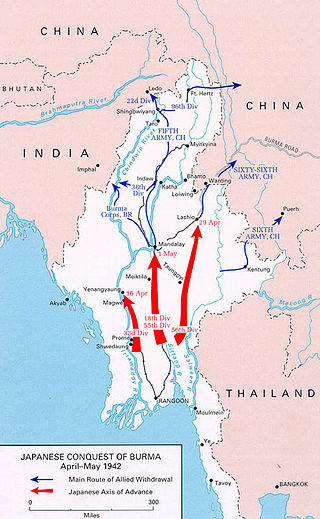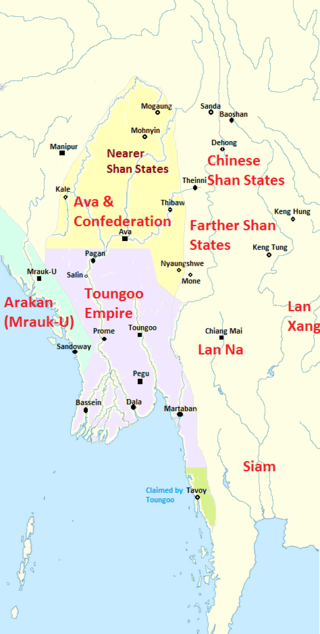
The Burma campaign was a series of battles fought in the British colony of Burma. It was part of the South-East Asian theatre of World War II and primarily involved forces of the Allies against the invading forces of the Empire of Japan. Imperial Japan was supported by the Thai Phayap Army, as well as two collaborationist independence movements and armies. Nominally independent puppet states were established in the conquered areas and some territories were annexed by Thailand. In 1942 and 1943, the international Allied force in British India launched several failed offensives to retake lost territories. Fighting intensified in 1944, and British Empire forces peaked at around 1 million land and air forces. These forces were drawn primarily from British India, with British Army forces, 100,000 East and West African colonial troops, and smaller numbers of land and air forces from several other Dominions and Colonies. These additional forces allowed the Allied recapture of Burma in 1945.

Tabinshwehti was King of Burma from 1530 to 1550, and the founder of the First Toungoo Empire. His military campaigns (1534–1549) created the largest kingdom in Burma since the fall of the Pagan Empire in 1287. His administratively fragile kingdom proved to be the impetus for the eventual reunification of the entire country by his successor and brother-in-law Bayinnaung.
The battle of Prome was a land-based battle between the Kingdom of Burma and the British Empire that took place near the city of Prome, modern day Pyay, in 1825 as part of the First Anglo-Burmese War. It was the last-ditch effort by the Burmese to drive out the British from Lower Burma. The poorly equipped Burmese army despite the advantage in numbers suffered a defeat. The British army's subsequent march toward north threatened Ava, which led to peace negotiation by the Kingdom of Burma.
Battle of Yunnan-Burma Road was the name of the Chinese intervention to aid their British allies in the 1942 Burma Campaign. Its forces were composed of the Fifth, Sixth and Sixty-sixth Army under the command of the Chinese Expeditionary Force in Burma, commanded by Lt. General Joseph Stilwell, Lt. General Luo Zhuoying was his executive officer.

The Battle of Yenangyaung was fought in Burma from 16 to 19 April 1942. As part of the Burma Campaign of World War II, the battle was fought between Chinese and British allied forces on one side and Japanese forces on the other. The battle took place in the vicinity of Yenangyaung and its oil fields.
The Battle of Tachiao, was the first clash in the Battle of Yunnan-Burma Road in the Burma Campaign of World War II and Second Sino-Japanese War.
The Battle of Toungoo was one of the key battles in the Battle of Yunnan-Burma Road in the Burma Campaign of World War II and Second Sino-Japanese War. The failure of the Chinese to hold the city of Toungoo opened up the route for the Japanese to make their lunge to Lashio around the allied flank and into the Chinese rear.
Nanda Bayin, was king of the Toungoo dynasty of Burma (Myanmar) from 1581 to 1599. He presided over the collapse of the First Toungoo Empire, the largest empire in the history of Southeast Asia.

The Japanese invasion of Burma was the opening phase of the Burma campaign in the South-East Asian theatre of World War II, which took place over four years from 1942 to 1945. During the first year of the campaign, the Japanese Army drove British Empire and Chinese forces out of Burma, then began the Japanese occupation of Burma and formed a nominally independent Burmese administrative government.
The Burma Corps ('Burcorps') was an Army Corps of the Indian Army during the Second World War. It was formed in Prome, Burma, on 19 March 1942, took part in the retreat through Burma, and was disbanded on arrival in India in May 1942.
Nyaungyan Min was king of the Toungoo dynasty of Burma (Myanmar) from 1599 to 1605. He is also referred to as the founder of the restored Toungoo dynasty or Nyaungyan dynasty for starting the reunification process following the collapse of the First Toungoo Empire.

The Battle of Naungyo was a land battle fought between the armies of the Toungoo Kingdom and Hanthawaddy Kingdom during the Toungoo–Hanthawaddy War (1534–41) in late 1538. The battle was the most decisive Toungoo victory of the war. Toungoo armies led by Gen. Kyawhtin Nawrahta decisively defeated a numerically far superior and better armed force of Hanthawaddy led by Gen. Binnya Dala and Gen. Minye Aung Naing. Only a small portion of the Hanthawaddy forces made it to their intended destination–the fortified city of Prome (Pyay). A decimated Hanthawaddy was no longer in a position to retake the lost territories from Toungoo.
The Prome Kingdom also known as Pyay Kingdom was a kingdom that existed for six decades between 1482 and 1542 in present-day central Burma (Myanmar). Based out of the city of Prome (Pyay), the minor kingdom was one of the several statelets that broke away from the dominant Ava Kingdom in the late 15th century. Throughout the 1520s, Prome was an ally of the Confederation of Shan States, and together they raided Avan territory. After Ava fell to the Confederation armies in 1527, Prome itself became a tributary of the Confederation in 1532. In the late 1530s, Prome became ensnarled in the Toungoo–Hanthawaddy War (1534–1541). Despite military assistance from the Confederation and the Mrauk U Kingdom, the small kingdom fell to the Toungoo (Taungoo) forces in 1542.
The military history of Myanmar (Burma) spans over a millennium, and is one of the main factors that have shaped the history of the country, and to a certain degree, the history of Southeast Asia. At various times in history, successive Burmese kingdoms were also involved in warfare against their neighbouring states in the surrounding regions of modern Burmese borders—from Bengal, Manipur and Assam in the west, to Yunnan (the southern China) in the northeast, to Laos and Siam in the east and southeast.
Smim Payu was a general and admiral of the Royal Burmese Armed Forces, and a senior minister at the court of King Tabinshwehti of Toungoo Dynasty from 1536 to 1544. The ethnic Mon commander was originally a minister at the court of King Takayutpi of Hanthawaddy but joined Tabinshwehti's service in 1536 and rose to be one of the top advisers to the Toungoo king. He is most well known for planning and commanding the 1541 naval attack on Martaban (Mottama) that finally breached the defenses of the last Hanthawaddy holdout, and ended the Toungoo–Hanthawaddy War (1534–41).
Thado Dhamma Yaza I was viceroy of Prome (Pyay) from 1542 to 1550 during the reign of his son-in-law King Tabinshwehti of Toungoo Dynasty of Burma (Myanmar), and the self-proclaimed king of the city-state from 1550 to 1551. After the death of Tabinshwehti in 1550, the man who started out as a royal household servant of Tabinshwehti in 1516 declared himself king of Prome with the style of Thado Thu, and did not submit to Bayinnaung, Tabinshwehti's chosen successor. His fortified city-state fell to Bayinnaung's forces in 1551 after a six-month battle. He was executed on the order of Bayinnaung, who later regretted the decision.
Thado Minsaw was viceroy of Ava (Inwa) from 1555 to 1584 during the reigns of kings Bayinnaung and Nanda of Toungoo Dynasty of Burma (Myanmar). He fought alongside his brothers Bayinnaung, Minye Sithu, Thado Dhamma Yaza II and Minkhaung II, and his nephew Nanda in nearly every campaign from the 1550s to 1570s that rebuilt, expanded and defended the Toungoo Empire. Two years after Bayinnaung's death, he raised the first serious rebellion against the rule of Nanda. Although his rebellion was defeated in April 1584, it had set in motion more rebellions elsewhere that ultimately led to the collapse of the empire in the next 15 years.

The Toungoo–Ava War (1538–1545) was a military conflict that took place in present-day Lower and Central Burma (Myanmar) between the Toungoo Dynasty, and the Ava-led Confederation of Shan States, Hanthawaddy Pegu, and Arakan (Mrauk-U). Toungoo's decisive victory gave the upstart kingdom control of all of central Burma, and cemented its emergence as the largest polity in Burma since the fall of Pagan Empire in 1287.
Thado Dhamma Yaza III was viceroy of Prome (Pyay) from 1589 to 1595, and self-styled king of Prome from 1595 to 1597. Hnaung was initially a loyal vassal of his father King Nanda until 1594 when he openly clashed with his brother Crown Prince Minye Kyawswa. Hnaung revolted in 1595 during the Siamese siege of Pegu (Bago). His revolt started a string of other revolts by the major vassal states of the Toungoo Empire in the next two years. His attempts to take over territories beyond Prome's traditional vassals in the present-day Magwe Region were unsuccessful. The self-proclaimed king was assassinated by Yan Naing, one of his trusted advisers, on the eve of his planned invasion of Upper Burma in 1597.
Minye Kyawhtin was a pretender to the Ava throne from 1426 to 1459. The eldest son of Crown Prince Minye Kyawswa, Minye Kyawhtin raised a long-running rebellion against King Mohnyin Thado and his successors, kings Minye Kyawswa I and Narapati I of Ava.





